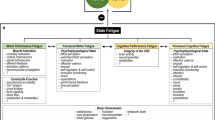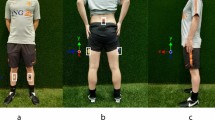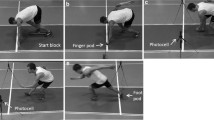Summary
By citing examples from actual work situations and discussing the concept of muscular endurance and fatigue this paper is intended to provide an account of past and current research on the “static” component of muscular load during work. By amplitude probability distribution analysis of electromyographic signals it is possible to estimate the “static level” of muscular load during work. Electromyographic studies of job rotation between different assembly tasks in electronic industries often show that there are quantitatively and qualitatively only small differences in muscular load between different tasks.
Similar content being viewed by others
References
Bigland-Ritchie B, Woods JJ (1974) Integrated EMG and oxygen uptake during dynamic contractions of human muscles. J Appl Physiol 36:475–479
Bigland-Ritchie B, Woods JJ (1976) Integrated electromyogram and oxygen uptake during positive and negative work. J Physiol 260:267–277
Björkstén M, Jonsson B (1977) Endurance limit of force in long term intermittent static contractions. Scand J Work Environment Health 3:23–27
Björkstén M, Itani T, Jonsson B, Yoshizawa M (1987) Evaluation of muscular load in shoulder and forearm muscles among medical secretaries during occupational typing and some nonoccupational activities. In: Jonsson B (ed) Biomechanics X-A. Human Kinetics Publ Champaign, pp 35–39
Bouisset S, Goubel F (1973) Integrated electromyographical activity and muscle work. J Appl Physiol 35:695–702
Christensen H (1986) Muscle activity and fatigue in the shoulder muscles during repetitive work. An electromyographic study. Eur J Appl Physiol 54:596–601
Christensen H, Lo Monaco M, Dahl K, Fuglsang-Frederiksen A (1984) Processing of electrical activity in human muscle during a gradual increase in force. Electroencephal Clin Neurophysiol 58:230–239
Granström B, Kvarnström S, Tiefenbacher F (1985) Electromyography as an aid in the prevention of excessive shoulder strain. Appl Ergonom 16:49–54
Hagberg C (1986) Electromyography and bite force studies of muscular function and dysfunction in masticatory muscles. Swedish Dent J [Suppl 37] Thesis
Hagberg M (1979) The amplitude distribution of surface EMG in static and intermittent static muscular performance. Eur J Appl Physiol 40:265–272
Hagberg M (1981a) Muscular endurance and surface electromyogram in isometric and dynamic exercise. J Appl Physiol: Respirat Environm Exerc Physiol 51:1–7
Hagberg M (1981b) Electromyographic signs of shoulder muscular fatigue in two elevated arm positions. Am Physical Med 60:111–121
Hagberg M (1981c) Work load and fatigue in repetitive arm elevations. Ergonomics 24:543–555
Hagberg M (1981d) On evaluation of local muscular load and fatigue by electromyography. Arbete och Hälsa, National Board of Occupational Safety and Health, Stockholm 1981:24, Thesis
Hagberg M, Jonsson B (1975a) The relationship between myoelectric activity and muscle work in intermittent statical contractions. Electromyogr Clin Neurophysiol 15:253–258
Hagberg M, Jonsson B (1975b) The amplitude distribution of the myoelectric signal in an ergonomic study of the deltoid muscle. Ergonomics 18:311–319
Hagberg M, Jonsson B, Brundin L, Ericson BE, Örtelius A (1983) An epidemiological, ergonomic and electromyographic study of musculo-skeletal complaints among meatcutters (Swedish text). National Board of Occupational Safety and Health, Stockholm, Arbete och Hälsa 1983:12
Hagner IM, Hagberg M, Hammarström U, Johansson M, Marklund M (1986) Workload in two floor-mopping methods (Swedish text). National Board of Occupational Safety and Health, Stockholm, Arbete och Hälsa 1986:29
Itani T, Yoshizawa M, Jonsson B (1987) Electromyographic evaluation and subjective estimation of the muscular load in shoulder and forearm muscles during some leisure activities. In: Jonsson B (ed) Biomechanics X-A. Human Kinetics Publ, Champaign, pp 241–247
Jonsson B (1976) Evaluation of the myoelectric signal in longterm vocational electromyography. In: Komi PV (ed) Biomechanics V-A. University Park Press, Baltimore, pp 509–514
Jonsson B (1978) Kinesiology. With special reference to electromyographic kinesiology. Contempor Clin Neurophysiol [EEG Suppl No 34] 417–428
Jonsson B (1982) Measurement and evaluation of local muscular strain in the shoulder during constrained work. J Human Ergol 11:73–88
Jonsson B (1984) Muscular fatigue and endurance. Basic research and ergonomic applications. In: Kumamoto M (ed) Neural and mechanical control of movement. Yamaguchi Shoten, Kyoto, pp 64–76
Jonsson B, Brundin L, Hagner IM, Coggman I, Sondell J (1985) Operating a forwarder: An electromyographic study. In: Winter DA, Norman RW, Wells RP, Hayes KC, Patla AE (eds) Biomechanics IX-B. Human Kinetics Publ, Champaign, pp 21–26
Jonsson B, Hagberg M, Sima S (1981) Vocational electromyography in shoulder muscles in an electronic plant. In: Morecki A, Fidelus K, Kedzior K, Wit A (eds) Biomechanics VII-B. PWN-Polish Scientific Publ, Warszawa, pp 10–15
Komi PV, Viitasalo JHT (1976) Signal characteristics of EMG at different levels of muscle tension. Acta Physiol Scand 96:267–276
Milner-Brown HS, Stein RB (1975) The relation between the surface electromyogram and muscular force. J Physiol 246:549–569
Milner-Brown HS, Stein RB, Yemm R (1973) The orderly recruitment of human motor units during voluntary isometric contractions. J Physiol 230:359–370
Petrofsky JS (1979) Frequency and amplitude analysis of the EMG during exercise on the bicycle ergometer. Eur J Appl Physiol 41:1–15
Rohmert W (1960) Ermittlung von Erholungspausen für statische Arbeit des Menschen. Internationale Z Angew Physiol Einschl Arbeitsphysiol 18:123–169
Rohmert W (1973a) Problems in determining rest allowances. Part 1: Use of modern methods to evaluate stress and strain in static muscular work. Appl Ergonom 4:91–95
Rohmert W (1973b) Problems in determining rest allowances. Part 2: Determining rest allowances in different human tasks. Appl Ergonom 4:158–162
Sjøgaard G, Kiens B, Jørgensen K, Saltin B (1986) Intramuscular pressure, EMG and blood flow during low-level prolonged static contraction in man. Acta Physiol Scand 128:475–484
Winkel J, Ekblom B, Hagberg M, Jonsson B (1983a) The working environment of cleaners. Evaluation of physical strain in mopping and swabbing as a basis for job redesign. In: Kvålseth TO (ed) Ergonomics of workstation design. Butterworts, London, pp 35–44
Winkel J, Ekblom B, Tillberg B (1983b) Ergonomic and medical factors in shoulder/arm pain among cabin attendants as a basis for job redesign. In: Matsui H, Kobayashi K (eds) Biomechanics VIII-A. Human Kinetics Publ Champaign, pp 567–573
Author information
Authors and Affiliations
Rights and permissions
About this article
Cite this article
Jonsson, B. The static load component in muscle work. Europ. J. Appl. Physiol. 57, 305–310 (1988). https://doi.org/10.1007/BF00635988
Accepted:
Issue Date:
DOI: https://doi.org/10.1007/BF00635988




